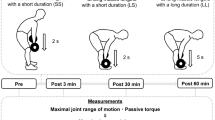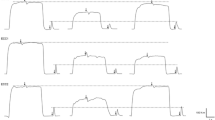Abstract
Purpose
The aim of the present study was to investigate whether the electrically evoked muscle responses are differently affected over time by the knee joint angle after an exercise-induced muscle damage (EIMD). We hypothesized that low-frequency-evoked responses would be less affected at long than short muscle length, and that mechanisms located within the muscle and tendinous tissues would be involved.
Methods
Fifteen males performed 45 min loaded downhill walking (DW) exercise. Maximal voluntary contraction torque (MVC), optimal angle for torque production, voluntary activation level (VAL), twitch, doublet at 10 and 100 Hz (Db10 and Db100, respectively), rate of torque development (RTD), post-activation potentiation (PAP), muscle shear elastic modulus (µ) and aponeurosis stiffness were assessed before, after, and 4, 24, 48, 72 and 168 h after the exercise at a knee angle of 40°, 90° and 120° (0°: full extension).
Results
MVC, VAL and Db100 were similarly decreased across joint angles after the DW and optimal angle was not affected. Twitch, Db10, Db10/Db100, PAP and RTD were less affected and muscle µ more increased at long than short muscle lengths (p < 0.05), especially during the first 24 h after the DW exercise.
Conclusion
Low-frequency-evoked responses were more preserved at long than short muscle length the first 24 h after the DW exercise, suggesting that joint angle should be taken into account to assess muscular alterations after EIMD. This length-dependence could be associated to the higher sensitivity to Ca2+ and the higher increase in muscle stiffness at long than short muscle length.






Similar content being viewed by others
Data availability
The datasets generated during and/or analysed during the current study are available from the corresponding author on reasonable request.
Abbreviations
- Ca2+ :
-
Calcium
- Db10:
-
Doublet at 10 Hz
- Db100:
-
Doublet at 100 Hz
- Db10/db100:
-
Low-frequency fatigue
- DW:
-
Downhill walking
- E–C coupling:
-
Excitation–contraction coupling
- EIMD:
-
Exercise-induced muscle damage
- KE:
-
Knee extensors
- MVC:
-
Maximal voluntary contraction
- NM:
-
Neuromuscular
- PAP:
-
Post-activation potentiation
- RF:
-
Rectus femoris
- ROI:
-
Region of interest
- RTD:
-
Rate of torque development
- TTL:
-
Transistor-transistor logic
- Twitch:
-
Mechanical response to a single stimulation
- Tw:
-
Non-potentiated twitch
- Twp :
-
Potentiated twitch
- µ:
-
Shear elastic modulus
- VAL:
-
Voluntary activation level
- VL:
-
Vastus lateralis
References
Allen DG, Lamb GD, Westerblad H (2008) Skeletal muscle fatigue: cellular mechanisms. Physiol Rev 88(1):287–332. https://doi.org/10.1152/physrev.00015.2007
Balnave CD, Allen DG (1996) The effect of muscle length on intracellular calcium and force in single fibres from mouse skeletal muscle. J Physiol 492:705–713. https://doi.org/10.1113/jphysiol.1996.sp021339
Bercoff J, Tanter M, Fink M (2004) Supersonic shear imaging: a new technique for soft tissue elasticity mapping. IEEE Trans Ultrason Ferroelectr Freq Control 51(4):396–409. https://doi.org/10.1109/tuffc.2004.1295425
Brockett CL, Morgan DL, Proske U (2001) Human hamstring muscles adapt to eccentric exercise by changing optimum length. Med Sci Sports Exerc 33(5):783–790
Byrne C, Eston RG, Edwards RH (2001) Characteristics of isometric and dynamic strength loss following eccentric exercise-induced muscle damage. Scand J Med Sci Sports 11(3):134–140
Chalchat E, Gennisson JL, Peñailillo L, Oger M, Malgoyre A, Charlot K, Bourrilhon C, Siracusa J, Garcia-Vicencio S (2020) Changes in the viscoelastic properties of the Vastus lateralis muscle with fatigue. Front Physiol 11:307. https://doi.org/10.3389/fphys.2020.00307
Child RB, Saxton JM, Donnelly AE (1998) Comparison of eccentric knee extensor muscle actions at two muscle lengths on indices of damage and angle-specific force production in humans. J Sports Sci 16(4):301–308. https://doi.org/10.1080/02640419808559358
Clarkson PM, Hubal MJ (2002) Exercise-induced muscle damage in humans. Am J Phys Med Rehabil 81(11 Suppl):S52-69. https://doi.org/10.1097/01.PHM.0000029772.45258.43
Edwards RH, Hill DK, Jones DA, Merton PA (1977) Fatigue of long duration in human skeletal muscle after exercise. J Physiol 272(3):769–778. https://doi.org/10.1113/jphysiol.1977.sp012072
Enoka SDG (1992) Neurobiology of muscle fatigue. J Appl Physiol 72(5):1631–1648. https://doi.org/10.1152/jappl.1992.72.5.1631
Heales LJ, Badya R, Ziegenfuss B, Hug F, Coombes JS, van den Hoorn W, Tucker K, Coombes BK (2018) Shear-wave velocity of the patellar tendon and quadriceps muscle is increased immediately after maximal eccentric exercise. Eur J Appl Physiol 118(8):1715–1724. https://doi.org/10.1007/s00421-018-3903-2
Hoffman BW, Cresswell AG, Carroll TJ, Lichtwark GA (2016) Protection from muscle damage in the absence of changes in muscle mechanical behavior. Med Sci Sports Exerc 48(8):1495–1505. https://doi.org/10.1249/MSS.0000000000000920
Howell JN, Chleboun G, Conatser R (1993) Muscle stiffness, strength loss, swelling and soreness following exercise-induced injury in humans. J Physiol 464:183–196. https://doi.org/10.1113/jphysiol.1993.sp019629
Ishikawa M, Dousset E, Avela J, Kyrolainen H, Kallio J, Linnamo V, Kuitunen S, Nicol C, Komi PV (2006) Changes in the soleus muscle architecture after exhausting stretch-shortening cycle exercise in humans. Eur J Appl Physiol 97(3):298–306. https://doi.org/10.1007/s00421-006-0180-2
Jacobs R, van Ingen Schenau GJ (1992) Control of an external force in leg extensions in humans. J Physiol 457:611–626. https://doi.org/10.1113/jphysiol.1992.sp019397
Lacourpaille L, Nordez A, Hug F, Couturier A, Dibie C, Guilhem G (2014) Time-course effect of exercise-induced muscle damage on localized muscle mechanical properties assessed using elastography. Acta Physiol 211(1):135–146. https://doi.org/10.1111/apha.12272
Lacourpaille L, Nordez A, Hug F, Doguet V, Andrade R, Guilhem G (2017) Early detection of exercise-induced muscle damage using elastography. Eur J Appl Physiol 117(10):2047–2056. https://doi.org/10.1007/s00421-017-3695-9
MacIntosh BR (2010) Cellular and whole muscle studies of activity dependent potentiation. Adv Exp Med Biol 682:315–342. https://doi.org/10.1007/978-1-4419-6366-6_18
MacIntosh BR (2017) Recent developments in understanding the length dependence of contractile response of skeletal muscle. Eur J Appl Physiol 117(6):1059–1071. https://doi.org/10.1007/s00421-017-3591-3
Maeo S, Saito A, Otsuka S, Shan X, Kanehisa H, Kawakami Y (2018) Localization of muscle damage within the quadriceps femoris induced by different types of eccentric exercises. Scand J Med Sci Sports 28(1):95–106. https://doi.org/10.1111/sms.12880
Maffiuletti NA, Aagaard P, Blazevich AJ, Folland J, Tillin N, Duchateau J (2016) Rate of force development: physiological and methodological considerations. Eur J Appl Physiol 116(6):1091–1116. https://doi.org/10.1007/s00421-016-3346-6
Merton PA (1954) Voluntary strength and fatigue. J Physiol 123(3):553–564. https://doi.org/10.1113/jphysiol.1954.sp005070
Millet GY, Martin V, Martin A, Vergès S (2011) Electrical stimulation for testing neuromuscular function: from sport to pathology. Eur J Appl Physiol 111(10):2489–2500. https://doi.org/10.1007/s00421-011-1996-y
Morgan DL, Allen DG (1999) Early events in stretch-induced muscle damage. J Appl Physiol 87(6):2007–2015. https://doi.org/10.1152/jappl.1999.87.6.2007
Paulsen G, Mikkelsen UR, Raastad T, Peake JM (2012) Leucocytes, cytokines and satellite cells: what role do they play in muscle damage and regeneration following eccentric exercise? Exerc Immunol Rev 18:42–97
Philippou A, Maridaki M, Bogdanis GC (2003) Angle-specific impairment of elbow flexors strength after isometric exercise at long muscle length. J Sports Sci 21(10):859–865. https://doi.org/10.1080/0264041031000140356
Pincheira PA, Hoffman BW, Cresswell AG, Carroll TJ, Brown NAT, Lichtwark GA (2018) The repeated bout effect can occur without mechanical and neuromuscular changes after a bout of eccentric exercise. Scand J Med Sci Sports 28(10):2123–2134. https://doi.org/10.1111/sms.13222
Prasartwuth O, Allen TJ, Butler JE, Gandevia SC, Taylor JL (2006) Length-dependent changes in voluntary activation, maximum voluntary torque and twitch responses after eccentric damage in humans. J Physiol 571(Pt 1):243–252. https://doi.org/10.1113/jphysiol.2005.101600
Proske U, Morgan DL (2001) Muscle damage from eccentric exercise: mechanism, mechanical signs, adaptation and clinical applications. J Physiol 537(Pt 2):333–345. https://doi.org/10.1111/j.1469-7793.2001.00333.x
Rassier DE, MacIntosh BR, Herzog W (1999) Length dependence of active force production in skeletal muscle. J Appl Physiol 86(5):1445–1457. https://doi.org/10.1152/jappl.1999.86.5.1445
Roszek B, Baan GC, Huijing PA (1994) Decreasing stimulation frequency-dependent length-force characteristics of rat muscle. J Appl Physiol 77(5):2115–2124. https://doi.org/10.1152/jappl.1994.77.5.2115
Saxton JM, Donnelly AE (1996) Length-specific impairment of skeletal muscle contractile function after eccentric muscle actions in man. Clin Sci (lond) 90(2):119–125. https://doi.org/10.1042/cs0900119
Schuklenk U (2001) Helsinki declaration revisions. Issues. Med Ethics 9(1):29
Siracusa J, Charlot K, Malgoyre A, Conort S, Tardo-Dino PE, Bourrilhon C, Garcia-Vicencio S (2019) Resting muscle shear modulus measured with ultrasound shear-wave elastography as an alternative tool to assess muscle fatigue in humans. Front Physiol 10:626. https://doi.org/10.3389/fphys.2019.00626
Skurvydas A, Brazaitis M, Kamandulis S, Sipaviciene S (2010) Peripheral and central fatigue after muscle-damaging exercise is muscle length dependent and inversely related. J Electromyogr Kinesiol off J Int Soc Electrophysiol Kinesiol 20(4):655–660. https://doi.org/10.1016/j.jelekin.2010.02.009
Verges S, Maffiuletti NA, Kerherve H, Decorte N, Wuyam B, Millet GY (2009) Comparison of electrical and magnetic stimulations to assess quadriceps muscle function. J Appl Physiol 106(2):701–710. https://doi.org/10.1152/japplphysiol.01051.2007
Warren GL, Lowe DA, Armstrong RB (1999) Measurement tools used in the study of eccentric contraction-induced injury. Sports Med 27(1):43–59. https://doi.org/10.2165/00007256-199927010-00004
Whitehead NP, Weerakkody NS, Gregory JE, Morgan DL, Proske U (2001) Changes in passive tension of muscle in humans and animals after eccentric exercise. J Physiol 533(Pt 2):593–604. https://doi.org/10.1111/j.1469-7793.2001.0593a.x
Yu JY, Jeong JG, Lee BH (2015) Evaluation of muscle damage using ultrasound imaging. J Phys Ther Sci 27(2):531–534. https://doi.org/10.1589/jpts.27.531
Acknowledgements
We would like to thank Benoît Lepetit, Stéphane Baugé, Phillippe Colin, Caroline Dussault, Stéphanie Bourdon, Marvin Subryan, Roxane Dubois, Alexandra Malgoyre, Pierre-Emmanuel Tardo-Dino, Walid Bouaziz, Olivier Nespoulous and the IRBA Biological Analyses Unit for their technical and medical support.
Author information
Authors and Affiliations
Contributions
EC, JS, SGV and VM designed the study and drafted the manuscript. EC, JS, KC and SGV collected the data. EC, SGV, J-LG and VM participated to the data analysis. KC designed the figures. All the authors contributed to the interpretation of the data and the edition of the manuscript.
Corresponding author
Ethics declarations
Conflict of interest
The authors report no conflict of interest. This work is known and agreed by the co-authors identified on the manuscript’s title page.
Additional information
Communicated by Nicolas Place.
Publisher's Note
Springer Nature remains neutral with regard to jurisdictional claims in published maps and institutional affiliations.
Rights and permissions
Springer Nature or its licensor (e.g. a society or other partner) holds exclusive rights to this article under a publishing agreement with the author(s) or other rightsholder(s); author self-archiving of the accepted manuscript version of this article is solely governed by the terms of such publishing agreement and applicable law.
About this article
Cite this article
Chalchat, E., Siracusa, J., Bourrilhon, C. et al. Contractile properties are less affected at long than short muscle length after eccentric exercise. Eur J Appl Physiol 123, 1101–1114 (2023). https://doi.org/10.1007/s00421-023-05134-2
Received:
Accepted:
Published:
Issue Date:
DOI: https://doi.org/10.1007/s00421-023-05134-2




